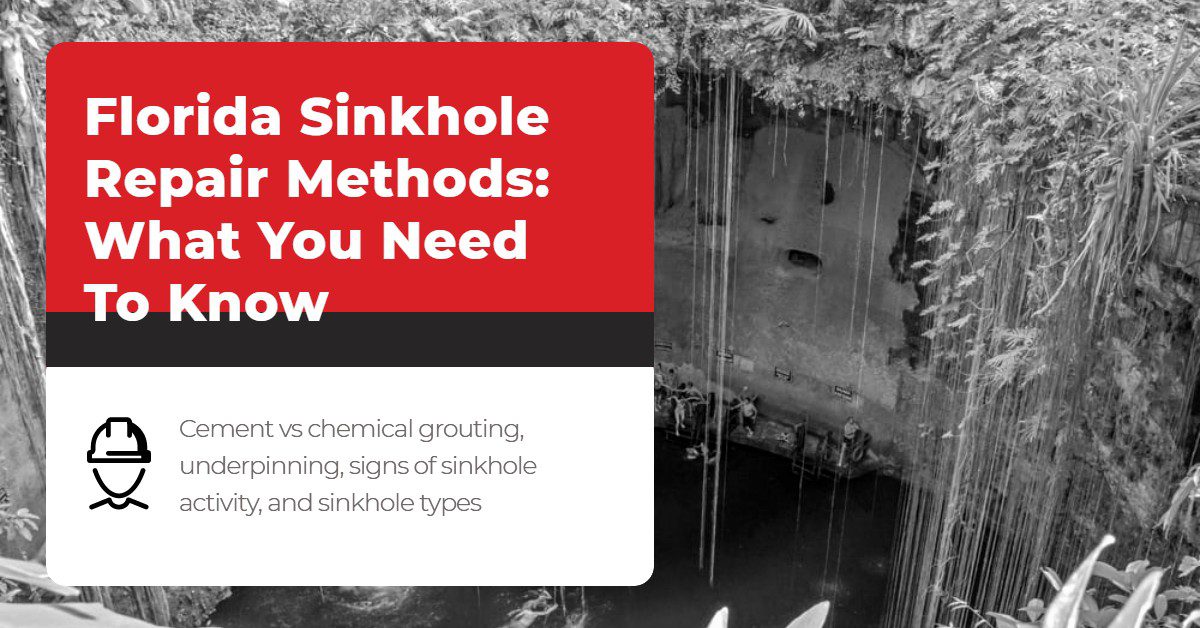What Exactly Is A Sinkhole?
In certain areas of the United States, including Florida, there are two rock types that can dissolve in water: evaporites (salt, gypsum, and anhydrite) and carbonates (limestone and dolomite). When this happens it can cause underground voids and sinkholes to form.
Sinkholes are common in Florida because much of the state sits atop these dissolvable types of rock. As rainwater gets into the soil it absorbs carbon dioxide and reacts with decaying vegetation. This creates slightly acidic water that then moves through underground voids and cracks slowly dissolving the limestone, and creating a network of cavities, fissures, and voids. As the limestone continues to dissolve, these voids and cracks get bigger and can then hold an even larger amount of acidic water. Sinkholes are formed when the earth’s surface material collapses, or sinks into the cavities. If a house is sitting atop a sinkhole, the damage caused by a collapse can be catastrophic.
Sinkholes come in a variety of shapes and sizes ranging from a few feet across and less than a foot deep to the 75-mile-wide Qattara Depression in northwestern Egypt which was created slowly via wind erosion. While most sinkholes are a naturally-occurring phenomenon, some sinkholes are manmade.

The Cenote Ik Kil sinkhole in Mexico
Different Types Of Sinkholes
Dissolution Sinkholes
Dissolution sinkholes form slowly, and happen when there isn’t a lot of soil or vegetation covering the limestone or bedrock. This allows water to slowly flow over the bedrock and dissolve it. This results in a depression that could turn into a pond if debris stops the water from draining. Dissolution sinkholes usually aren’t dangerous.
Subsidence Sinkholes
Subsidence sinkholes form when rainwater soaks through permeable sediment (with a lot of sand in it) and reaches the limestone, dissolving and weakening it. These sinkholes form naturally over time as small cracks in the limestone grow wider and wider due to erosion. Sediment from upper layers of land fill the cracks and at some point a depression will start to form on the ground’s surface.
Cover Collapse Sinkholes
Cover collapse sinkholes usually form when there’s a layer of clay under the ground cover, but above the bedrock. Sediment from the ground level erodes over time, and when only a thin layer remains, a sinkhole can open up quickly, revealing the underground void that has been forming. Cover collapse sinkholes are dangerous because they can collapse quickly.
Not all sinkholes occur naturally. Some are caused by human activity such as pumping groundwater during freezes to prevent crop damage, excavating, drilling wells, landfill creation, broken water lines or leaks, and pounding or blasting for construction or mining. Even decomposed buried debris can appear as a sinkhole.
Sinkhole Repair Methods
There are two primary sinkhole repair methods: grouting and underpinning.
Grouting involves injecting grout into the soil in order to stabilize it. It stops the soil from shifting or moving, and fills voids created by sinkhole activity. There are two types of grouting: cement and chemical.
Cement Grouting
Cement grouting involves injecting a cement-based grout into the sinkhole via steel casings. We use high pressure to pump the grout deep underground. Shallower parts of the sinkhole can often be filled with wetter type cement/slurry mixtures. This method fills voids and seals limestone. Cement grouting also provides the residence, structure, or roadway with a denser, more stable soil base.
Chemical Grouting
This type of grouting is also known as polyurethane grouting. It involves injecting a resin (usually polyurethane) into a sinkhole in order to fill the void. The polyurethane resin expands into an inert foam, and lifts and stabilizes the slab or floor. The amount of pressure and expansion depend on the type of chemical compound used.
Underpinning
Underpinning involves stabilizing and releveling a structure via steel piers. The piers are installed until they reach load-bearing soil, and then the concrete slab or foundation is hydraulically lifted. It’s important to understand that underpinning does not fix the sinkhole. It fixes and stabilizes the damage to the structure caused by the sinkhole. Therefore, underpinning is a solution that’s sometimes used in conjunction with grouting.
Which solution used depends on a variety of factors including the damage caused by the sinkhole, and the makeup of the land underneath the affected structure.
What Are The Signs Of A Sinkhole?
Signs of a sinkhole include:
- Ground depressions
- Leaning trees or fence poles
- Subsiding soil
- Exposed foundations
- Exposed tree roots
- Structural cracks in doors, windows, or walls
- Foundation settlement
- Wilting vegetation in circular patches
- Small ponds
- Deep vertical holes of all sizes
If You See Signs Of Sinkhole Activity…
Sinkholes can be both beautiful and destructive. If you’ve noticed signs of sinkhole activity, contact a foundation repair professional that specializes in sinkhole remediation right away and have them come out for an inspection. Be aware that some, if not most, foundation repair companies advertise sinkhole remediation even though they’ve never performed the tasks necessary to repair sinkhole activity.
Read more about – What is soil scouring?
If you’re within our service area, contact us for a free estimate. After a careful inspection and engineering review of your sinkhole, our team will select the right sinkhole remediation method. We have over 40 years of experience in geotechnical sciences, and we can handle any kind of sinkhole.

